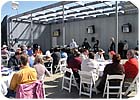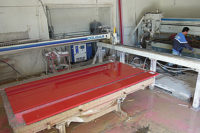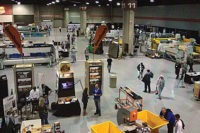
The 2006 edition of the Building Stone Institute (BSI) Convention was held in San Diego, CA, from March 1 to 4.
Always taking place in a desirable locale, the 2006 edition of the Building Stone Institute (BSI) Convention was held in San Diego, CA, from March 1 to 4, giving attendees the chance to enjoy the Southern California climate in between the educational sessions, networking opportunities and other institute business.

Outgoing BSI President Brenda Edwards of TexaStone Quarries praised her fellow members and BSI Executive Vice President Jeff Buczkiewicz for the progress made in the recent past, including the new image of the organization and its increased work with the architecture community. Edwards was also named the BSI's Person of the Year at the gala dinner on the convention's final evening.
In individual reports, Scott Beuchel, outgoing treasurer of the BSI, reported a positive cash flow, and Rob Teel presented a Membership Committee Report that stated the organization has 300 members and is looking to grow more in the near future.

Rick Jones of Stonecraft, Inc. in Knoxville, TN, was named the new president of the BSI.
New BSI officers
A new slate of BSI officers was also named, and current roster of board members is as follows:- Rick Jones, Stonecraft, Inc., Knoxville, TN (President)
- Scott Beuchel, Beuchel Stone Corp., Fond du Lac, WI (Vice President)
- Bob Barden, Barden Stone Inc., Memphis, TN (Treasurer)
- Doug Bachli, Colorado Flagstone, Inc., Masonville, CO (Secretary)
- Brenda Edwards, TexaStone Quarries, Garden City, TX (Immediate Past President)
- Robert Barnes, Jr., Dee Brown, Inc., Dallas, TX
- Mary Dillon, Cherryland Cut Stone & Marble Co., Traverse City, MI
- Al Gregory, JMS/Jura Marble Suppliers, Fredericksburg, VA
- Robert Hicken, Delta Stone Products, Heber City, UT
- Chuck Monson, Dakota Granite Co., Milbank, SD
- Liz Serven, Silverado Building Materials, Sacramento, CA
- Thomas Schlough, Park Industries, St. Cloud, MN
- Ronald Vetter, Vetter Stone Co., Kasota, MN
- Jonathan Zanger, Walker Zanger, Inc., Mt. Vernon, NY

In the first educational session, Donato Pompo of Ceramic Tile And Stone Consultants presented “Natural Stone Trends: What lies in the future?†Among other figures, he reported that natural stone consumption in the U.S. totaled $5.89 billion in 2005, more than double the amount reported in 2002.
Educational sessions
The BSI Convention included a seminar program that took place each morning from March 2 to 4, and it included a range of topics of interest to the stone industry. The following is a sampling of some of the sessions that took place in San Diego:
Natural Stone Trends
In the first session, Donato Pompo of Ceramic Tile And Stone Consultants presented “Natural Stone Trends: What lies in the future?†Pompo reported that the average stone price per metric ton in 2005 was $1,021, a 9% decreased from 2002's reported figure of $1,126.
He also shared the following figures:
- Natural stone consumption in the U.S. totaled $5.89 billion in 2005, more than double the amount reported in 2002. Moreover, that figure of $5.89 billion is nearly double the value of ceramic tile sold in the U.S. in 2005, which was reported to be $3.04 billion.
- The average cost per square foot in 2005 was $6.16 for stone and $0.95 for ceramic tile.
- In the construction industry, the countertop market is currently 47.8% natural stone.
- Slab fabricators/installers in the U.S. saw revenue of $3.7 billion in 2005, with a 35.5% margin.

In a session entitled “The Stone Center,†Dean Casad of Park Industries explained the benefits of stone fabricators becoming a “one-stop shop†for their customers. Using “big box†retailers such as Lowe's and Home Depot as a model, Casad explained how a shop can benefit by offering more uses for stone and more stone products.
Bernard Buster of Lyons Sandstone presented “Immigration Law (H-2B Bill),†which explained the H-2B labor certification program, which establishes a means for nonagricultural employers who anticipate a shortage of domestic works to bring temporary nonimmigrant foreign workers into the U.S.
The employer must establish facts that support a finding that the need for labor is a one-time occurrence or of a seasonal basis. Employers can apply for certification by dealing with multiple federal agencies, or they can work with an immigration attorney or association to shepherd the certification process through federal agencies.
Of interest to the stone industry, masons and masonry helpers, quarry workers and other laborers are eligible under the terms of the program. Certification is valid for 364 days.
The Stone Center
In “The Stone Center,†Dean Casad of Park Industries explained the benefits of stone fabricators becoming a “one-stop shop†for their customers. Using “big box†retailers such as Lowe's and Home Depot as a model, Casad explained how a shop can benefit by offering more uses for stone and more stone products. Specifically, he cited new stone uses in areas such as living rooms, entertainment centers and architectural accents. He also explained how to increase stone use in kitchens, where material can be used as range hoods, sinks, decorative panels, etc.
Casad cited how today's homeowners in residences valued at $250,000 and up are potential customers; not only the upper class. He concluded by urging attendees to proactively inspire customers with brochures, an interactive Web site, books, model homes, samples and an effective showroom.

Addressing a very important safety issue, Joe O'Connor of INTEC spoke on silicosis, a respiratory disease caused by inhalation of silica dust - a particular concern to stone production companies. O'Connor discussed the allowable standards for silica particles as determined by OSHA, and he also detailed the levels of symptoms of silicosis.
Addressing a very important safety issue, Joe O'Connor of INTEC spoke on silicosis, a respiratory disease caused by inhalation of silica dust - a particular concern to stone production companies. O'Connor discussed the allowable standards for silica particles as determined by OSHA, and he also detailed the levels of symptoms of silicosis.
In discussing how to protect against silicosis, O'Connor discussed monitoring methods, respirators, medical surveillance and training.
Finding your Brand “Voiceâ€
Joe Myers of the MyersCroxton Group guided participants through a discussion of “branding,†which he defined as the identifying mark or label on the products of a particular company. He stressed how branding can build a business, increase customer loyalty and ultimately increase sales.
The session offered branding techniques as well as a forecast for branding strategy in a more intensely competitive future.

Mike Beckmann and Paul Klees (pictured) of Bonstone Materials presented a session on the uses and applications of resins in the stone industry. Among other information, the session also addressed the pros and cons of the various adhesive types.
Fred Jackson and Paul Moretti took part in “ Resin Facts, Fiction and Issues,†an open forum discussion introduction of resin into granite and the challenges and issues it presents to the stone industry. Speakers discussed how resin affects the material and how a fabricator can identify if a resin has been applied. They also discussed how to educate customers on resin treatment.
Adhesives
Mike Beckmann and Paul Klees of Bonstone Materials presented a session on the uses and applications of resins in the stone industry. They addressed the chemical structures of epoxy and polyester resin products, their characteristics, properties, favorable conditions for use, countertop applications and more. The session also addressed the pros and cons of the various adhesive types.

As part of the activities during the Building Stone Institute Convention in San Diego, CA, attendees were given a guided tour of Petco Park, home to Major League Baseball's San Diego Padres, which is clad in sandstone from India.
Ballpark tour highlights BSI convention
As part of the educational sessions at the Building Stone Institute Convention in San Diego, CA, attendees received a guided tour of Petco Park, home of Major League Baseball's San Diego Padres. The ballpark utilizes 160,000 square feet of sandstone from India, which was used in a tile format.
The ballpark utilizes 160,000 square feet of sandstone from India, which was used in a tile format. The material, which is named “Padre Gold®,†was supplied through Modern Builders Supply of San Marcos, CA, and Stone A.V. USA, Inc., of Plano, TX.
Capitalizing on the city's favorable natural climate, the stadium is arranged as an open air “garden†- with multiple stone-clad buildings rather than a general seating bowl - allowing fans premium views of the field while also enjoying the beauty of the surrounding environment. And to enhance the stadium experience, premium materials such as Indian sandstone were selected to reflect the Torrey Pines cliffs of the San Diego coastline.

Capitalizing on the city's favorable natural climate, the stadium is arranged as an open air “garden†- with multiple stone-clad buildings rather than a general seating bowl.

Tile sizes used for Petco park included 24 x 24, 24 x 18 and 24 x 12 inches.
The stone was shipped from India to the jobsite in San Diego over the course of 30 container loads, and material was shipped at an average rate of 2.5 containers per month.

The stone was shipped from India to the jobsite in San Diego over the course of 30 container loads, and material was shipped at an average rate of 2.5 containers per month.
The vast majority of the material has a cleft finish, and the amount of texture was also carefully determined in advance. “The owners wanted more cleft, and the installers of course wanted less,†said Muralidhar. In addition to the cleft finish, some of the stone at a waterfall feature was given a honed finish.

As part of the ballpark tour, BSI Convention attendees took part in a question-and-answer session that involved Sharad Muralidhar of Stone A.V. (pictured holding the microphone) and Andy Stallings of Hines Development, the development manager for the project (standing at the far right).
The executive architect for the stadium was HOK Sport, and the design architect was Antoine Predock, who has used Indian sandstone for landmark projects in the past. The stone was installed by Klaser Tile, Inc. of Chula Vista, CA.




